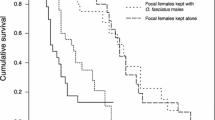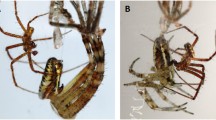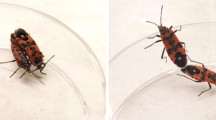Abstract
Mating with the wrong species is surprisingly common in nature. Interspecific mating can lead to reproductive interference, where wasted time, energy, nutrients, or gametes reduces the fitness of one or both of the interacting species. However, the ecological and evolutionary forces that maintain this seemingly maladaptive behavior remain poorly understood, in part because the natural complexity of heterospecific encounters is often not considered experimentally. The goal of this study was to directly test if the negative effects of heterospecific mating can be mitigated by conspecific mating. We used two closely related species of squash bug, Anasa tristis and Anasa andresii, which are known to readily mate with each other despite clear negative fitness consequences. We gave all females opportunities to mate with conspecific males before and after encountering heterospecific males. We found that A. tristis females can alleviate temporary bouts of heterospecific interference when given opportunities to mate with conspecifics. However, we found the opposite for A. andresii females. Mating with conspecifics did not shelter female A. andresii from the consequences of heterospecific mating. Our study reveals the complex dynamics of reproductive interference and highlights scenarios where mating with the wrong species can have either minimal or long-lasting effects on fitness. We emphasize the benefit of assessing reproductive interference using experiments that not only vary heterospecific encounter rates, but that also quantify lifetime measures of fitness. Our study adds to the growing body of research highlighting the importance of reproductive interference and sheds light on why this seemingly paradoxical behavior continues to persist.




Similar content being viewed by others
References
Andrews RH, Petney TN, Bull CM (1982) Reproductive interference between three parapatric species of reptile tick. Oecologia 52:281–286
Bates D, Maechler M, Bolker B, Walker S (2015) Fitting linear mixed-effects models using lme4. J Stat Softw 67(1):1–48. https://doi.org/10.18637/jss.v067.i01
Beard RL (1940) The biology of Anasa tristis DeGeer with particular reference to the tachinid parasite, Trichopoda pennipes. Fabr Conn Agric Exp Stn Bull 440:597–679
Bonjour EL, Fargo WS, Al-Obaidi AA, Payton ME (1993) Host effects on reproduction and adult longevity of squash bugs (Heteroptera: Coreidae). Environ Entomol 22:1344–1348
Burdfield-Steel ER, Auty S, Shuker DM (2015) Do the benefits of polyandry scale with outbreeding? Behav Ecol 26:1423–1431
Burdfield-Steel ER, Shuker DM (2011) Reproductive interference. Curr Biol 21:R450–R451
Clemente SH, Santos I, Ponce R, Rodrigues LR, Varela SAM, Magalhães S (2018) Despite reproductive interference, the net outcome of reproductive interactions among spider mite species is not necessarily costly. Behav Ecol 29:321–327
Dame EA, Petren K (2006) Behavioural mechanisms of invasion and displacement in Pacific island geckos (Hemidactylus). Anim Behav 71:1165–1173
Deering MD, Scriber JM (2002) Field bioassays show heterospecific mating preference asymmetry between hybridizing North American Papilio butterfly species (Lepidoptera: Papilionidae). J Ethol 20:25–33
Drury JP, Anderson CN, Cabezas Castillo MB, Fisher J, McEachin S, Grether GF (2019) A general explanation for the persistence of reproductive isolation. Am Nat. https://doi.org/10.1086/704102
Fujimoto H, Hiramatsu T, Takafuji A (1996) Reproductive interference between Panonychus mori and P. citri (Acari: Tetranychidae) in peach orchards. Appl Entomol Zool 31:59–65
Gomez-Llano MA, Bensch HM, Svensson EI (2018) Sexual conflict and ecology: species composition and male density interact to reduce male mating harassment and increase female survival. Evolution 72:906–915
Grether GF, Drury JP, Okamoto KW, McEachin S, Anderson CN (2020) Predicting evolutionary reponses to interspecific interference in the wild. Ecol Lett 23:221–230
Gröning J, Hochkirch A (2008) Reproductive interference between animal species. Quart Rev Biol 83:257–282
Hamel JA, Eskeland EE, Lehmann TK, Stover PL (2018) Reproductive costs for hybridizing female Anasa tristis (Hemiptera: Coreidae), but no evidence of selection against interspecific mating. J Insect Sci 18:1–7
Hamel JA, Nease SA, Miller CW (2015) Male mate choice and female receptivity lead to reproductive interference. Behav Ecol Sociobiol 69:951–956
Hettyey A, Pearman PB (2003) Social environment and reproductive interference affect reproductive success in the frog Rana latastei. Behav Ecol 14:294–300
Hochkirch A, Gröning J, Bücker A (2007) Sympatry with the devil: reproductive interference could hamper species coexistence. J Anim Ecol 76:633–642
Howard DJ, Gregory PG, Chu J, Cain ML (1998) Conspecific sperm precedence is an effective barrier to hybridization between closely related species. Evolution 52:511–516
Jones T (1916) Notes on Anasa andresii Guer. J Econ Entomol 9:431–434
Kishi S, Nishida T, Tsubaki Y (2009) Reproductive interference determines persistence and exclusion in species interactions. J Anim Ecol 78:1043–1049
Kokko H, Klug H, Jennions MD (2014) Mating systems. In: Shuker DM, Simmons LW (eds) The evolution of insect mating systems. Oxford University Press, Oxford, UK, pp 42–58
Konuma J, Chiba S (2007) Ecological character displacement caused by reproductive interference. J Theory Biol 247:354–364
Kuno E (1992) Competitive exclusion through reproductive interference. Res Popul Ecol 34:275–284
Kuznetsova A, Brockhoff PB, Haubo R, Christensen B (2016) lmerTest Package: tests in linear mixed effects models. R package version 2.0–30. https://CRAN.Rproject.org/package=lmerTest
Kyogoku D, Nishida T (2013) The mechanism of the fecundity reduction in Callosobruchus maculatus caused by Callosobruchus chinensis males. Popul Ecol 55:87–93
Kyogoku D, Wheatcroft D (2020) Heterospecific mating interactions as an interface between ecology and evolution. J Evol Biol 33:1330–1344
Lipshutz SE (2018) Interspecific competition, hybridization, and reproductive isolation in secondary contact: missing perspectives on males and females. Curr Zool 64:75–88
Liu S, De Barro PJ, Xu J, Luan J, Zang L, Ruan Y, Wan F (2007) Asymmetric mating interactions drive widespread invasion and displacement in a whitefly. Science 318:1769–1772
Lorch PD, Servedio MR (2007) The evolution of conspecific gamete precedence and its effect on reinforcement. J Evol Biol 20:937–949
Manzano-Winkler B, Hish AJ, Aarons EK, Noor MAF (2017) Reproductive interference by male Drosophila subobscura on female D. persimilis: a laboratory experiment. Ecol Evol 7:2268–2272
Marshall VT, Schwartz JJ, Gerhardt HC (2006) Effects of heterospecific call overlap on the phonotactic behaviour of grey treefrogs. Anim Behav 72:449–459
McLain DK, Shure DJ (1987) Pseudocompetition: interspecific displacement of insect species through misdirected courtship. Oikos 49:291–296
Moore P (2014) Reproductive physiology and behavior. In: Shuker DM, Simmons LW (eds) The evolution of insect mating systems. Oxford University Press, Oxford, UK, pp 78–91
Nasci RS, Hare SG, Willis FS (1989) Interspecific mating between Louisiana strains of Aedes albopictus and Aedes aegypti in the field and laboratory. J Am Mosq Control Assoc 5:416–421
Nechols JR (1987) Voltinism, seasonal reproduction, and diapause in the squash bug (Heteroptera: Coreidae). Kans Environ Entomol 16:269–273
Noriyuki S, Osawa N (2016) Reproductive interference and niche partitioning in Aphidophagous insects. Psyche 2016:4751280
Price CS (1997) Conspecific sperm precedence in Drosophila. Nature 388:663–666
R Core Team (2016) R: a language environment for statistical computing. Vienna, Austria: R Foundation for Statistical Computing.https://www.R-project.org/
Reinhardt K (2006) Sperm numbers vary between inter- and intra-population matings of the grasshopper Chorthippus parallelus. Biol Lett 2:239–241
RStudio: Integrated Development for R (2015) RStudio, Inc, Boston, MA. http//www.rstudio.com
Schraft HA (2017) Mobility cost of copulation is independent of female:male size ratio in Anasa tristis. Southwest Nat 62:162–165
Shuker DM, Burdfield-Steel ER (2017) Reproductive interference in insects. Ecol Entomol 42:65–75
Simmons LW (2014) Sperm competition. In: Shuker DM, Simmons LW (eds) The evolution of insect mating systems. Oxford University Press, Oxford, UK, pp 181–203
Svensson EI, Eroukhmanoff F, Karlsson K, Runemark A, Brodin A (2010) A role for learning in population divergence of mate preferences. Evolution 64:3101–3113
Takafuji A, Kuno E, Fujimoto H (1997) Reproductive interference and its consequences for the competitive interactions between two closely related Panonychus spider mites. Exp Appl Acarol 21:379–391
Therneau TM, Grambsch PM (2000) Modeling survival data: extending the Cox model. Springer, New York, New York, USA
Thum RA (2007) Reproductive interference, priority effects and the maintenance of parapatry in Skistodiaptomus copepods. Oikos 116:759–768
Tyler F, Harrison XA, Bretman A, Veen T, Rodríguez-Muñoz R, Tregenza T (2013) Multiple post-mating barriers to hybridization in field crickets. Mol Ecol 22:1640–1649
Valero A, Garcia CM, Magurran AE (2008) Heterospecific harassment of native endangered fishes by invasive guppies in Mexico. Biol Lett 4:149–152
Wade MJ, Patterson H, Chang NW, Johnson NA (1994) Postcopulatory, prezygotic isolation in flour beetles. Heredity 72:163–167
Wirtz P (1999) Mother species-father species: unidirectional hybridization in animals with female choice. Anim Behav 58:1–12
Yeates SE, Diamond SE, Einum S, Emerson BC, Holt WV, Gage MJ (2013) Cryptic choice of conspecific sperm controlled by the impact of ovarian fluid on sperm swimming behavior. Evolution 67:3523–3536
Acknowledgements
We thank N. Lindo, V. Wu for help talking care of the squash bugs, and E. Edwards for help rearing plants. We also thank J. Hamel, J. de Roode, S. Mendiola, K. Stoy, and the rest of the GerDer group for discussion and other assistance. Funding for this work was supported by a National Institutes of Health K12 Grant (GM00680) as well as a USDA-NIFA Grant (2019-67013-29371) to NMG. SMV was also supported by Emory University, an Institutional Research and Academic Career Development Award (IRACDA), and the Fellowships in Research and Science Teaching (FIRST) postdoctoral program. The authors declare no conflicts of interest.
Author information
Authors and Affiliations
Corresponding author
Additional information
Publisher's Note
Springer Nature remains neutral with regard to jurisdictional claims in published maps and institutional affiliations.
Supplementary Information
Below is the link to the electronic supplementary material.
Rights and permissions
About this article
Cite this article
Villa, S.M., Han, D.D., Jordan, M.E. et al. The resilience of reproductive interference. Evol Ecol 35, 537–553 (2021). https://doi.org/10.1007/s10682-021-10120-1
Received:
Accepted:
Published:
Issue Date:
DOI: https://doi.org/10.1007/s10682-021-10120-1




